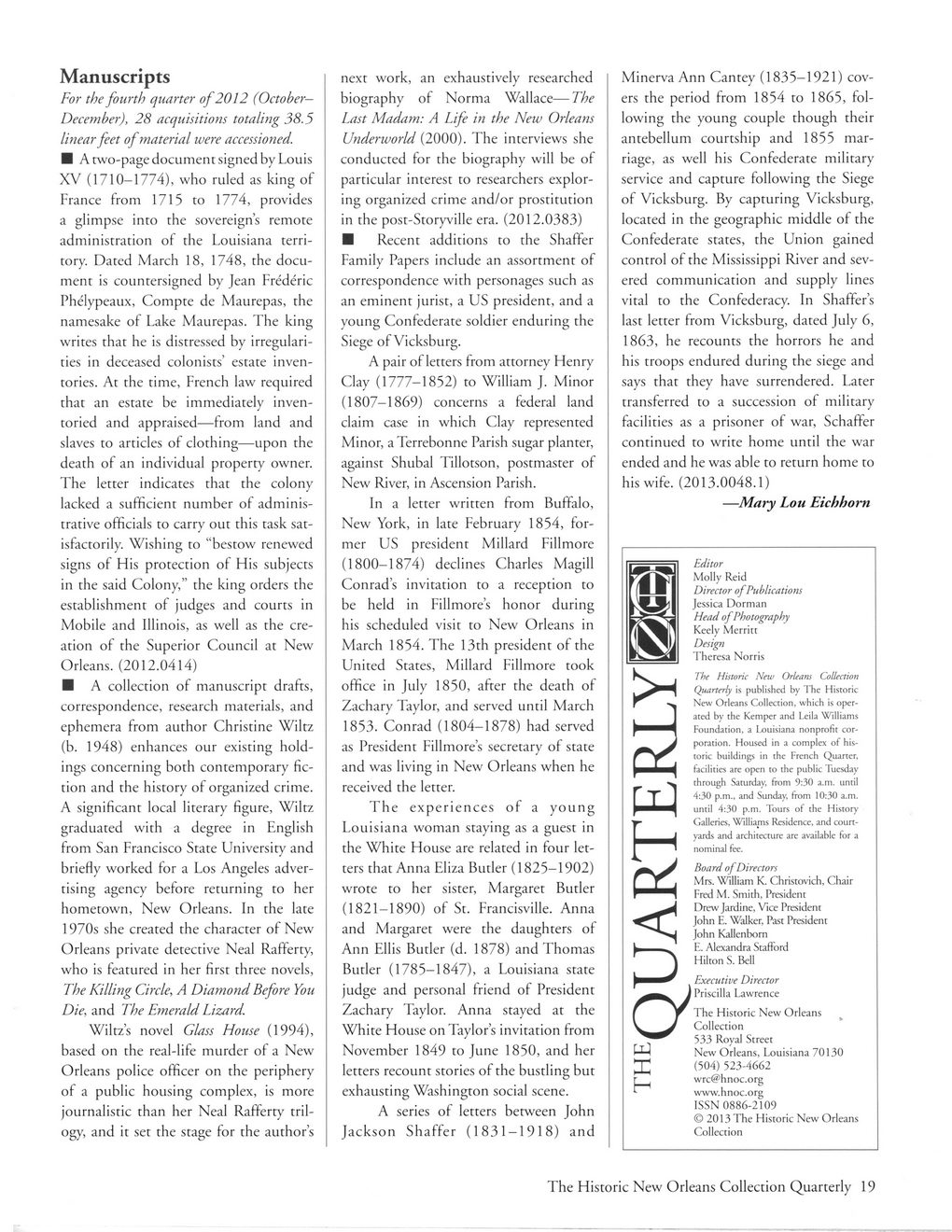This text was obtained via automated optical character recognition.
It has not been edited and may therefore contain several errors.
Manuscripts For the fourth quarter of 2012 (October-December), 28 acquisitions totaling 38.5 linear feet of material were accessioned. M A two-page document signed by Louis XV (1710-1774), who ruled as king of France from 1715 to 1774, provides a glimpse into the sovereign’s remote administration of the Louisiana territory. Dated March 18, 1748, the document is countersigned by Jean Frederic Phelypeaux, Compte de Maurepas, the namesake of Lake Maurepas. The king writes that he is distressed by irregularities in deceased colonists’ estate inventories. At the time, French law required that an estate be immediately inventoried and appraised—from land and slaves to articles of clothing—upon the death of an individual property owner. The letter indicates that the colony lacked a sufficient number of administrative officials to carry out this task satisfactorily. Wishing to “bestow renewed signs of His protection of His subjects in the said Colony,” the king orders the establishment of judges and courts in Mobile and Illinois, as well as the creation of the Superior Council at New Orleans. (2012.0414) ■ A collection of manuscript drafts, correspondence, research materials, and ephemera from author Christine Wiltz (b. 1948) enhances our existing holdings concerning both contemporary fiction and the history of organized crime. A significant local literary figure, Wiltz graduated with a degree in English from San Francisco State University and briefly worked for a Los Angeles advertising agency before returning to her hometown, New Orleans. In the late 1970s she created the character of New Orleans private detective Neal Rafferty, who is featured in her first three novels, The Killing Circle, A Diamond Before You Die, and The Emerald Lizard. Wiltz’s novel Glass Flouse (1994), based on the real-life murder of a New Orleans police officer on the periphery of a public housing complex, is more journalistic than her Neal Rafferty trilogy, and it set the stage for the author’s next work, an exhaustively researched biography of Norma Wallace—The Last Madam: A Life in the New Orleans Underworld (2000). The interviews she conducted for the biography will be of particular interest to researchers exploring organized crime and/or prostitution in the post-Storyville era. (2012.0383) I Recent additions to the Shaffer Family Papers include an assortment of correspondence with personages such as an eminent jurist, a US president, and a young Confederate soldier enduring the Siege of Vicksburg. A pair of letters from attorney Henry Clay (1777-1852) to William J. Minor (1807-1869) concerns a federal land claim case in which Clay represented Minor, a Terrebonne Parish sugar planter, against Shubal Tillotson, postmaster of New River, in Ascension Parish. In a letter written from Buffalo, New York, in late February 1854, former US president Millard Fillmore (1800-1874) declines Charles Magill Conrad’s invitation to a reception to be held in Fillmore’s honor during his scheduled visit to New Orleans in March 1854. The 13th president of the United States, Millard Fillmore took office in July 1850, after the death of Zachary Taylor, and served until March 1853. Conrad (1804-1878) had served as President Fillmore’s secretary of state and was living in New Orleans when he received the letter. The experiences of a young Louisiana woman staying as a guest in the White House are related in four letters that Anna Eliza Butler (1825-1902) wrote to her sister, Margaret Butler (1821-1890) of St. Francisville. Anna and Margaret were the daughters of Ann Ellis Butler (d. 1878) and Thomas Butler (1785-1847), a Louisiana state judge and personal friend of President Zachary Taylor. Anna stayed at the White House on Taylor’s invitation from November 1849 to June 1850, and her letters recount stories of the bustling but exhausting Washington social scene. A series of letters between John Jackson Shaffer (1831 — 1918) and Minerva Ann Cantey (1835-1921) covers the period from 1854 to 1865, following the young couple though their antebellum courtship and 1855 marriage, as well his Confederate military service and capture following the Siege of Vicksburg. By capturing Vicksburg, located in the geographic middle of the Confederate states, the Union gained control of the Mississippi River and severed communication and supply lines vital to the Confederacy. In Shaffer’s last letter from Vicksburg, dated July 6, 1863, he recounts the horrors he and his troops endured during the siege and says that they have surrendered. Later transferred to a succession of military facilities as a prisoner of war, Schaffer continued to write home until the war ended and he was able to return home to his wife. (2013.0048.1) —Mary Lou Eichhom Editor Molly Reid Director of Publications Jessica Dorman Head of Photography Keely Merritt Design Theresa Norris The Historic New Orleans Collection Quarterly is published by The Historic New Orleans Collection, which is operated by the Kemper and Leila Williams Foundation, a Louisiana nonprofit corporation. Housed in a complex of historic buildings in the French Quarter, facilities are open to the public Tuesday through Saturday, from 9:30 a.m. until 4:30 p.m., and Sunday, from 10:30 a.m. until 4:30 p.m. Tours of the History Galleries, Williams Residence, and courtyards and architecture are available for a nominal fee. Board of Directors Mrs. William K. Christovich, Chair Fred M. Smith, President Drew Jardine, Vice President John E. Walker, Past President John Kallenbom E. Alexandra Stafford Hilton S. Bell Executive Director Priscilla Lawrence The Historic New Orleans Collection 533 Royal Street New Orleans, Louisiana 70130 (504) 523-4662 wrc@hnoc.org www.hnoc.org ISSN 0886-2109 © 2013 The Historic New Orleans Collection The Historic New Orleans Collection Quarterly 19

New Orleans Quarterly 2013 Spring (19)